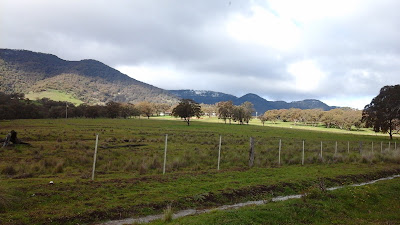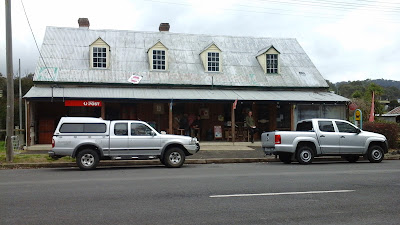If Smith and Denny were filled with wonder and delight by Ebor Falls, they would've wet themselves had they seen Wollomombi, Chandler or Dangars Falls. All of these are just south of the aptly named Waterfall Way, the road from Ebor to Armidale. However, as Edward said their object was to
feed and preserve the condition of our horses, rather than a search for the picturesque so the stockmen were denied this pleasure.
 |
| Wollomombi Falls. At 220m the second highest waterfall in Australia and perhaps consequently, the second most visited park in NSW. |
All these falls drop off the edge of the plateau and create steep, deep gorges that would be well nigh impossible to cross. Presumably Edward knew they were there because otherwise it would've made sense for him to head more south west than he did. Trish and I, however, with our modern mode of rapid transit could allow ourselves a search for the picturesque so we did just that and picturesque they certainly are. As a side note, after seeing a lyre bird at Wollomombi Falls, I asked a Park Ranger if they were common. He was just telling me that they were, and pointing out the scratchings they make, when as if to emphasise the point, another lyre bird strolled across the path about 20m behind him!
 |
| Not easy country. Chandlers Gorge down from Wollomombi Falls |
Edward was keen to cross this high ground as quickly as possible because he was worried about the effect of the cold on his horses (not to mention his staff) so he determined to travel as quickly as possible - about 50km/day. He noted that on this trip
such a degree of cold is very unusual even in this cold region of Australia. Must've been cold.
One of the pleasures of this trip is that it has provided the excuse to chat with a wide variety of people along the way, quizzing them for knowledge of things that aren't immediately apparent in relation to Edward's diary. One little mystery that had presented itself was the location of Hall's Station, the next stop he made for the purpose of
replenishing our now nearly exhausted flour bags and to
obtain nails and tools to reshoe one of the draught horses which was becoming lame due to having lost 2 shoes. At Hall's, thanks to the presence of a looking glass, he was able to have his first shave since leaving Ramornie a week earlier. I don't need a looking glass because I have a wife who reminds me every few days that I need a shave, and I have an electric razor to do it with. Neither mirror nor lather required.
Internet searches had provided references to it and it seemed to be somewhere around Wollomombi but none offered a clue to its precise location. In addition, they were all from the mid to late 1800s so it was clear that the name had changed many years ago, hence the lack of current knowledge. From Ebor I had been quizzing locals, park rangers, Post Office and shop keepers and caravan park staff but all to no avail.
However, in the Armidale Tourist Info Centre, I asked John, a particularly friendly and helpful volunteer who said he had lived locally for 60 or so years. John said he hadn't heard of it but he provided me with a phone number for Judy, a doyenne of local history. John said that if she didn't know, no-one would. Despite it being a Sunday afternoon, John assured me that if it would be ok to ring her which I did. She said that off hand she couldn't tell me but if I was to ring back later she would do some asking around and might be able to tell me.
We spent the late afternoon at the Armidale Bowling club watching the Dockers beat Brisbane (great year this one) and enjoying the "roast of the day" before calling back and as John had assured me, Judy had done the job. She was able to tell me that Hall's Station belonged to Thomas Simpson Hall who had sold it in the 1860s when it's name became Wallamumbi, the name it carries today. Like me, Judy obviously enjoys her history and said that she'd enjoyed her afternoon chasing up the story and she was able to give me all sorts of information about the place, including the fact that Thomas Hall is regarded as the original breeder of the Blue Heeler!
 |
| Looking north east from Wollomombi village, this is the view across Wallamumbi station today. |
Judy also suggested I visit the Archives of the University of New England because one of the people she'd spoken to was Bill the archivist there and he had suggested that they might have some maps showing the location and tracks of that time so this afternoon, after enjoying a 3 hour heritage bus tour of Armidale, thats what we did. (The bus tour is a great initiative of the City of Armidale. Its free but donations are requested to keep it going. Haven't seen anything like it anywhere else.) Spent a couple of enjoyable hours at the archives and while there were no really usable maps there were several interesting documents relating to the history of the area and mentioning Edward.
 |
| From a fascinating document in the Archives, W. Gardners "Resources of the Northern Districts" this sketch depicts Rockvale, the station adjoining Halls, in 1855. |
Armidale existed in 1854, having a population of 547 in 1851 but Edward didn't call in here, instead cutting across the
wide plains of Gostwick and Salisbury just to the south east.
I enjoyed a peaceful cycle along the road to Dangars Falls which are created by Salisbury Waters. While it was chilly, it was warm compared to Edward's visit when
icicles hung from their (the horses)
noses and the hoar frost whitened their backs.
 |
| Spot the friendly rock wallaby we met at Dangars Falls. Generally considered endangered, there's a happy little colony here. |











































